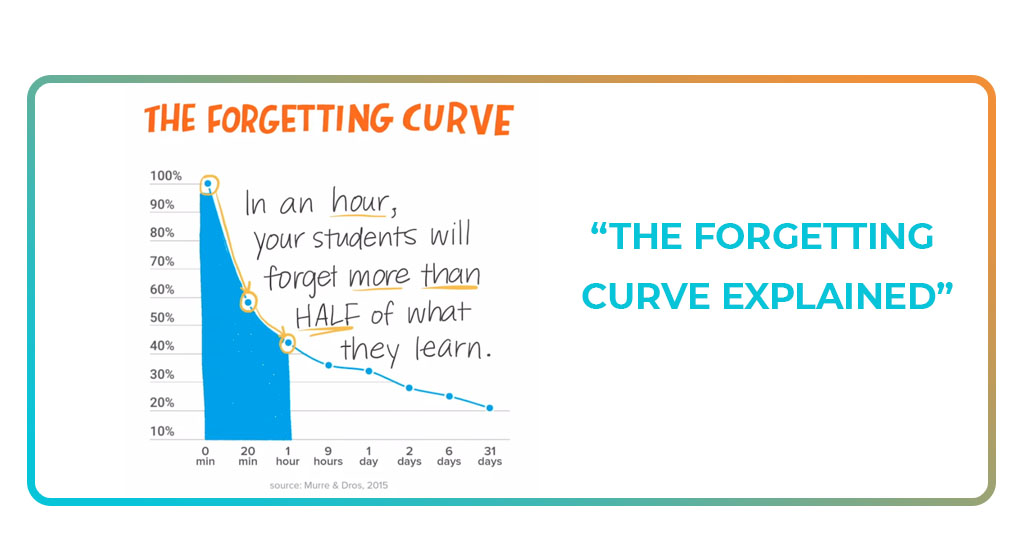You might feel motivated after finishing an online lesson, but a few days later, most of it slips away. Many people think this is about focus or discipline, but in reality, it’s how memory works. The forgetting curve describes how new knowledge fades from the brain over time when it’s not actively reinforced. This is the reason why some online courses, that often lack structured review, are harder to retain even the most interesting topics.
Therefore, knowing how and why we forget can completely change how we learn. Some digital tools can help with simple techniques, making it possible to shift from short-term memorization to lasting understanding. The article below explains what the forgetting curve is, how it affects online learning, and what you can do today to beat it.
- 4 applications éducatives de réalité augmentée pour améliorer votre expérience d'apprentissage
- 5 Apps to Learn Coding Anywhere and Become a Pro
- Advancing Language Learning in 2025: Top Innovative Apps
Understanding the science behind the forgetting curve
First of all, to learn how to retain knowledge, it is essential to understand the science behind the forgetting curve.
The forgetting curve is a psychological model developed by Hermann Ebbinghaus in the late 19th century.
The theory shows how memory retention drops sharply after initial learning unless the information is reviewed at spaced intervals.
According to this model, we forget over 50% of new information within an hour if we don’t review it.
After one day, that loss can exceed 70%, and after a week, almost all of it fades without reinforcement.
This steep decline happens because our brains naturally prioritize information that’s repeated or connected to context.
Consequently, one-time exposures, like a quick online video or text lesson, rarely activate long-term memory processes.
Understanding this curve is essential for anyone who wants to learn effectively. It shifts the focus from how much you learn in one session to how well you review what you’ve already seen.

Why you forget most of what you learn online
To explain this excess of forgetfulness, you need to know that most online content is designed only for delivery, not for retention.
Most courses often emphasize speed and completion rather than integration, leaving students with minimal chances to revisit or apply the material.
Even well-produced tutorials can become ineffective if users binge-watch them without time for repetition or reflection.
Consequently, the illusion of progress creates a false sense of mastery that fades quickly when the brain isn’t engaged deeply.
In summary, without structured practice or scheduled recall, the brain treats the information as non-essential. It doesn’t matter if the topic was fascinating, if the learning process lacks reinforcement, forgetting is almost guaranteed.
This is why passive learning feels satisfying in the moment but leaves little behind days later. To retain more, the format and timing of your study sessions matter just as much as the content itself.
Spaced Repetition Apps That Help You Beat the Curve
However, we already have some tools to “fight” the forgetting curve. For instance, it is scientifically proven that spaced repetition is a method that helps you retain knowledge by reviewing it right before your brain is about to forget.
That said, Insiderbits brings in this article a review about Anki and Brainscape apps that teach this strategy and help you insert into your daily routine with zero guesswork.
AnkiMobile Flashcards
To begin with, Anki (iOS/Android) uses a smart algorithm to space your reviews based on how well you recall each item.
For example, if a card feels easy, it won’t reappear for a while. Otherwise, if it’s hard, Anki brings it back sooner, just when your brain is close to forgetting.
The dynamic system powered by Anki helps users strengthen weak points without wasting time on what they already know. Over time, the deck adapts completely to your memory performance.
Moreover, users can create their own cards and even download public decks made by others.
To make it easy, the app also supports tagging and card organization, which helps you manage larger topics without losing focus.
Therefore, Anki is a platform that aims to transform scattered content into long-term knowledge.
4.9/5
Brainscape – Smart Flashcards
Brainscape (iOS/Android), in its turn, takes a structured approach to spaced repetition by letting users rate how confident they feel about each answer.
Then, the platform adjusts the review timing based on that self-assessment, building more practice into areas that need it most.
For instance, these subjects range from languages to business topics and standardized tests.
Within Brainscape, it is also possible to create your own decks with multimedia content and track your progress visually over time.
Brainscape’s learning analytics give insight into your strengths and weaknesses, helping you optimize study efforts.
Overall, it is a solid choice for learners who value structure, feedback, and personalized pacing.
4.7/5
Tips to turn online learning into long-term memory
To overcome the forgetting curve, you first need to know that timing and engagement matter more than sheer volume.
One of the best strategies is active recall, so testing yourself instead of re-reading or rewatching will force your brain to retrieve knowledge, strengthening the memory trace.
Also, breaking sessions into smaller parts with time between them is more effective than long, uninterrupted study blocks.
In addition to these strategies, rather than cramming everything into a weekend binge, you can increase some review checkpoints across your week.
Remember to take notes by hand if possible, because the process slows you down just enough to absorb what you’re reading and gives you material to revisit later with more context.
Finally, teach what you’ve learned to someone else, or explain it aloud to yourself. If you can summarize the concept without looking, your brain is more likely to retain it for good.
Flashcards and learning techniques that really work
Overall, flashcards remain one of the simplest and most powerful learning tools because they apply active recall and spaced repetition in one, forcing the brain to work harder, which builds stronger connections over time.
Now, it is not necessary to memorize full paragraphs: break ideas into short questions and answers. Focus each card on one concept only. This keeps the review fast and prevents mental overload.
Then, use digital flashcards for convenience, but make them specific to your own learning needs.
When it comes to generic decks, they may save time, but custom cards made from your own notes stick longer because they reflect your voice and logic.
Other techniques like dual coding or interleaving topics during study sessions also support better retention.
Ultimately, the key is to move from passive input to active engagement at every step.
The forgetting curve: why you can’t retain online learning – Conclusion
Understanding the forgetting curve gives you an edge most learners never develop. It shifts your focus from passive review to meaningful repetition, helping you retain more with less effort.
The apps we listed above can replace guesswork with timing, making memory something you build, not something you lose.
Learning doesn’t fail because of lack of interest. It fades when the method doesn’t match how the brain works. With the right approach, online learning becomes a part of what you know.
En rapport : AI-Powered Memory Boosters: Apps That Train Your Brain
Enjoyed this article? Save the Insiderbits blog to your favorites for the latest tools, creative tech tips, and photo editing breakthroughs.





